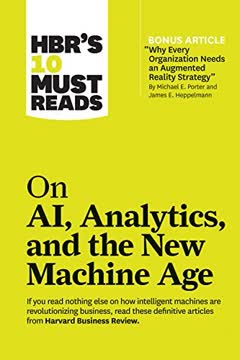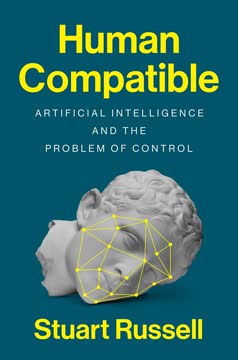Key Takeaways
1. Machine learning enables computers to learn from data without explicit programming
Machine learning is not just the commercial application of methods to extract information from data; learning is also a requisite of intelligence.
Data-driven intelligence. Machine learning algorithms allow computers to improve their performance on tasks through experience, rather than following pre-programmed rules. This approach is particularly powerful for problems where writing explicit algorithms is difficult or impossible, such as recognizing faces or understanding speech. By analyzing large datasets, machine learning models can discover patterns and make predictions without being explicitly told how to do so.
Key applications:
- Spam filtering
- Product recommendations
- Credit scoring
- Medical diagnosis
- Autonomous vehicles
Machine learning has become the driving force behind many recent advances in artificial intelligence, revitalizing the field after earlier disappointments with rule-based expert systems. As data becomes more abundant and computing power increases, machine learning techniques are likely to play an even greater role in shaping the future of AI and its applications across industries.
2. Supervised learning maps inputs to outputs, while unsupervised learning finds patterns
In machine learning, the aim is to construct a program that fits the given data.
Types of learning. Supervised learning involves training models on labeled data, where both inputs and desired outputs are provided. The goal is to learn a function that can accurately map new inputs to correct outputs. Common supervised tasks include classification (assigning inputs to discrete categories) and regression (predicting continuous values).
Unsupervised learning, in contrast, works with unlabeled data to discover hidden structures or patterns. Key unsupervised techniques include:
- Clustering: Grouping similar data points together
- Dimensionality reduction: Finding lower-dimensional representations of data
- Anomaly detection: Identifying unusual or outlier data points
Both approaches have their strengths and are often used in combination. Supervised learning excels at specific prediction tasks, while unsupervised learning can reveal unexpected insights and is particularly useful when labeled data is scarce or expensive to obtain.
3. Neural networks and deep learning power breakthroughs in AI
Deep learning methods are attractive mainly because they need less manual interference.
Brain-inspired computing. Artificial neural networks, inspired by the structure of biological brains, consist of interconnected layers of simple processing units. Deep learning extends this concept with many layers, allowing the automatic learning of hierarchical features from raw data. This approach has led to dramatic improvements in areas like computer vision, speech recognition, and natural language processing.
Key advantages of deep learning:
- Automatic feature extraction from raw data
- Ability to capture complex, non-linear relationships
- Scalability to very large datasets and model sizes
Notable deep learning architectures:
- Convolutional Neural Networks (CNNs) for image processing
- Recurrent Neural Networks (RNNs) for sequential data
- Transformers for natural language tasks
The success of deep learning has reignited interest in neural network approaches and driven significant investment in AI research and development across academia and industry.
4. Reinforcement learning allows systems to learn through trial and error
Though reinforcement learning algorithms are slower than supervised learning algorithms, it is clear that they have a wider variety of application and have the potential to construct better learning machines.
Learning by doing. Reinforcement learning enables agents to learn optimal behaviors through interaction with an environment. Unlike supervised learning, there's no predefined "correct" answer; instead, the agent learns to maximize a reward signal over time. This approach is particularly suited for sequential decision-making problems and has led to breakthroughs in game-playing AI and robotics.
Key components of reinforcement learning:
- Agent: The learner or decision-maker
- Environment: The world the agent interacts with
- State: The current situation
- Action: What the agent can do
- Reward: Feedback from the environment
Notable successes include:
- DeepMind's AlphaGo defeating world champions in the game of Go
- OpenAI's Dota 2 bot competing at a professional level
- Autonomous robotic systems learning complex motor skills
Reinforcement learning's ability to learn in complex, dynamic environments makes it a promising approach for developing more adaptable and general-purpose AI systems.
5. Big data and cloud computing fuel advances in machine learning
We have big data, but tomorrow's data will be bigger.
Scale drives progress. The explosion of digital data and the availability of powerful cloud computing resources have been crucial enablers of recent machine learning advances. Larger datasets allow models to learn more complex patterns, while distributed computing makes it feasible to train and deploy increasingly sophisticated algorithms.
Key trends:
- Growth in data generation from IoT devices, social media, and digital transactions
- Advancements in data storage and processing technologies
- Democratization of AI through cloud-based machine learning platforms
The synergy between big data and machine learning creates a virtuous cycle: better models lead to more useful applications, which in turn generate more data for further improvements. This dynamic is likely to continue driving rapid progress in AI capabilities across various domains.
6. Machine learning drives innovations in computer vision, speech recognition, and natural language processing
Machine learning plays a significant role in self-driving cars that will result in both smoother driving, faster control, and greater fuel efficiency, but also in smart sensing, for example, by automatic recognition of pedestrians, cyclists, traffic signs, and so forth.
Transforming human-computer interaction. Machine learning has enabled dramatic improvements in how computers perceive and interact with the world. In computer vision, deep learning models can now recognize objects, faces, and scenes with near-human accuracy. Speech recognition systems power virtual assistants and real-time translation services. Natural language processing algorithms are improving machine translation, text summarization, and question-answering systems.
Key application areas:
- Autonomous vehicles
- Medical imaging and diagnosis
- Smart home devices
- Language translation services
- Content recommendation systems
These advancements are making human-computer interaction more natural and intuitive, opening up new possibilities for AI-assisted tools and services across industries.
7. Ethical considerations and data privacy are crucial as AI becomes more pervasive
As we collect and analyze more and more data, our decisions in various domains will become more and more automated and data-driven, and we need to be concerned about the implications of such autonomous processes and the decisions they make.
Responsible AI development. As machine learning systems become more powerful and widespread, it's crucial to address ethical concerns and potential negative impacts. Key issues include data privacy, algorithmic bias, transparency and explainability of AI decisions, and the societal implications of automation.
Important considerations:
- Ensuring fairness and non-discrimination in AI systems
- Protecting individual privacy in data collection and analysis
- Developing explainable AI models for critical applications
- Addressing potential job displacement due to AI automation
- Establishing regulatory frameworks for AI development and deployment
Researchers, policymakers, and industry leaders must work together to develop ethical guidelines and best practices for responsible AI development. This includes promoting diversity in AI research teams, conducting thorough impact assessments, and fostering public dialogue about the role of AI in society.
8. The future of AI lies in more intelligent and adaptable systems
When will we reach that level of intelligence and how much processing and training will be required are yet to be seen. Currently machine learning seems to be the most promising way to achieve it, so stay tuned.
Towards artificial general intelligence. While current AI systems excel at specific tasks, the long-term goal is to develop more flexible and general-purpose intelligence. This involves creating systems that can transfer knowledge between domains, learn with less data, and adapt to new situations more easily.
Promising research directions:
- Meta-learning: Learning how to learn more efficiently
- Few-shot learning: Generalizing from very few examples
- Multimodal learning: Integrating information from diverse data types
- Causal reasoning: Understanding cause-and-effect relationships
The path to more advanced AI systems will likely involve combining insights from machine learning, neuroscience, cognitive science, and other disciplines. As these systems become more capable, it will be crucial to ensure they are developed in ways that align with human values and benefit society as a whole.
Last updated:
FAQ
What's "Machine Learning: The New AI" by Ethem Alpaydın about?
- Overview of Machine Learning: The book provides a comprehensive introduction to machine learning, explaining how it enables computers to learn from data and improve their performance over time.
- Historical Context: It traces the evolution of machine learning from its early days to its current status as a key component of artificial intelligence.
- Applications and Implications: The book discusses various applications of machine learning, from facial recognition to autonomous vehicles, and explores its implications for the future of technology and society.
- Educational Resource: It serves as an educational resource for those new to the field, offering insights into the fundamental concepts and methodologies of machine learning.
Why should I read "Machine Learning: The New AI" by Ethem Alpaydın?
- Comprehensive Introduction: The book is an excellent starting point for anyone interested in understanding the basics of machine learning and its role in artificial intelligence.
- Expert Insights: Written by a leading expert in the field, it provides authoritative insights into the principles and practices of machine learning.
- Real-World Applications: It offers numerous examples of how machine learning is applied in various industries, making the concepts more relatable and easier to understand.
- Future Implications: The book discusses the potential future developments in machine learning, helping readers understand its long-term impact on technology and society.
What are the key takeaways of "Machine Learning: The New AI"?
- Learning from Data: Machine learning involves creating algorithms that allow computers to learn from and make predictions based on data.
- Supervised vs. Unsupervised Learning: The book explains the difference between supervised learning, where models are trained on labeled data, and unsupervised learning, which involves finding patterns in unlabeled data.
- Neural Networks and Deep Learning: It covers the basics of neural networks and the concept of deep learning, which involves training models with multiple layers of abstraction.
- Ethical Considerations: The book highlights the ethical and privacy concerns associated with machine learning, emphasizing the need for responsible use of technology.
What are the best quotes from "Machine Learning: The New AI" and what do they mean?
- "A quiet revolution has been taking place in computer science for the last two decades." This quote highlights the transformative impact of machine learning on the field of computer science.
- "Machine learning is not just the commercial application of methods to extract information from data; learning is also a requisite of intelligence." It underscores the importance of machine learning in developing intelligent systems.
- "The aim of this book is to give the reader an overall idea about what machine learning is, the basics of some important learning algorithms, and a set of example applications." This quote encapsulates the book's purpose as an educational resource for understanding machine learning.
How does Ethem Alpaydın explain the concept of supervised learning in "Machine Learning: The New AI"?
- Definition and Process: Supervised learning is described as a process where models are trained on labeled data, meaning the input data is paired with the correct output.
- Examples Provided: The book provides examples such as credit scoring and image recognition to illustrate how supervised learning is applied in real-world scenarios.
- Model Training: It explains how models learn to make predictions by minimizing the difference between their predictions and the actual outcomes in the training data.
- Importance of Labeled Data: The book emphasizes the necessity of having a large and diverse set of labeled data to train effective supervised learning models.
What is unsupervised learning according to "Machine Learning: The New AI"?
- Definition and Purpose: Unsupervised learning involves finding patterns or structures in data without pre-existing labels, aiming to discover hidden relationships.
- Clustering and Association: The book discusses methods like clustering, which groups similar data points, and association, which finds rules that describe large portions of the data.
- Applications: Examples include customer segmentation and market basket analysis, where unsupervised learning helps identify natural groupings or associations in data.
- Exploratory Nature: It highlights the exploratory nature of unsupervised learning, which can reveal insights that were not previously considered.
How does "Machine Learning: The New AI" describe neural networks and deep learning?
- Neural Networks Basics: The book explains neural networks as models composed of interconnected nodes (neurons) that process information in layers.
- Deep Learning Concept: Deep learning is described as using neural networks with many layers to learn complex patterns in data, allowing for high-level abstractions.
- Applications and Successes: It discusses the success of deep learning in fields like image and speech recognition, where it has achieved state-of-the-art results.
- Training Challenges: The book also addresses the challenges of training deep networks, such as the need for large datasets and significant computational resources.
What role does probability play in machine learning according to Ethem Alpaydın?
- Modeling Uncertainty: Probability is used to model uncertainty in data and predictions, allowing for more robust decision-making.
- Bayesian Methods: The book covers Bayesian methods, which incorporate prior knowledge into the learning process to improve model predictions.
- Randomness in Data: It explains how probability helps account for randomness and noise in data, which can affect the accuracy of machine learning models.
- Decision Making: Probability is crucial in decision-making processes, such as calculating expected values to choose the best course of action.
What ethical considerations are discussed in "Machine Learning: The New AI"?
- Data Privacy: The book emphasizes the importance of protecting individuals' privacy when collecting and analyzing data for machine learning.
- Bias and Fairness: It discusses the potential for bias in machine learning models and the need for fairness in their development and deployment.
- Transparency and Accountability: The book advocates for transparency in how machine learning models are trained and used, ensuring accountability for their outcomes.
- Impact on Society: It highlights the broader societal implications of machine learning, including its potential to disrupt industries and affect employment.
How does "Machine Learning: The New AI" address the future of machine learning?
- Continued Growth: The book predicts continued growth and integration of machine learning into various aspects of technology and daily life.
- Advancements in Algorithms: It anticipates advancements in algorithms that will enable more efficient and accurate learning from data.
- Interdisciplinary Impact: The book foresees machine learning impacting a wide range of fields, from healthcare to finance, by providing new insights and capabilities.
- Ethical and Regulatory Challenges: It acknowledges the ethical and regulatory challenges that will need to be addressed as machine learning becomes more pervasive.
What is the significance of reinforcement learning in "Machine Learning: The New AI"?
- Learning from Interaction: Reinforcement learning is described as a method where agents learn by interacting with their environment and receiving feedback in the form of rewards.
- Applications in Gaming: The book highlights its use in gaming, where reinforcement learning has been used to develop agents that can play complex games like Go and chess.
- Delayed Rewards: It explains the concept of delayed rewards, where the agent must learn to associate actions with outcomes that occur much later.
- Exploration vs. Exploitation: The book discusses the balance between exploration (trying new actions) and exploitation (using known actions) to maximize rewards.
How does Ethem Alpaydın explain the concept of clustering in "Machine Learning: The New AI"?
- Grouping Similar Data: Clustering is described as the process of grouping similar data points together based on their attributes.
- Unsupervised Learning Method: It is an unsupervised learning method, meaning it does not rely on labeled data to find patterns.
- Applications in Segmentation: The book provides examples such as customer segmentation, where clustering helps identify distinct groups within a dataset.
- Exploratory Analysis: Clustering is used for exploratory data analysis, revealing natural groupings that may not have been previously considered.
Review Summary
Machine Learning receives mixed reviews, with an average rating of 3.62/5. Readers appreciate its accessible introduction to machine learning concepts, though some find it too basic or dry. The book is praised for balancing technical details with high-level explanations, making it suitable for non-experts seeking an overview. However, some criticize its lack of practical examples and outdated information. While valuable for understanding fundamental concepts, it may not satisfy those looking for in-depth technical knowledge or hands-on application.
Similar Books






Download PDF
Download EPUB
.epub digital book format is ideal for reading ebooks on phones, tablets, and e-readers.





